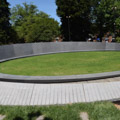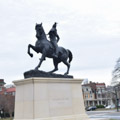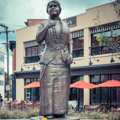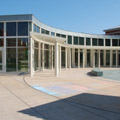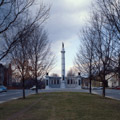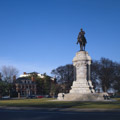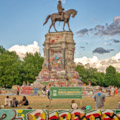Recent decades have brought new attention to the creation of more inclusive narratives of the American past, beyond those associated with the dominant white culture. In architectural history, this work has helped to expand the canon beyond high-style buildings to embrace local history and the vernacular landscape. In Virginia, documentation efforts have focused on recognizing the role of people of color, and African Americans in particular, in shaping the built environment, and scholarly interpretations have helped to present a richer and more nuanced history of even the most familiar monuments and places.
Black people have been central to Virginia’s history since the first ship brought enslaved Africans to Jamestown harbor in 1619. The enslaved population grew from nine percent of the Virginia population in 1700 to twenty-five percent by 1715 and forty percent by 1750. This percentage remained mostly steady through Reconstruction, despite a dip to thirty-one percent on the eve of the Civil War. During the Jim Crow era and especially during the Great Migration, Black Virginians left the state in increasing numbers and, today, they account for about twenty percent of the state’s population, residing mainly in the eastern half of the state, which was historically the center of the plantation economy.
Though white laborers, both indentured and independent, initially worked Virginia’s plantations, they were largely replaced by a Black workforce of enslaved people. It was because of Black laborers that Virginia thrived economically in the eighteenth and first half of the nineteenth centuries. The majority of enslaved people worked on plantations, not only in the fields, but also as blacksmiths, carpenters, and engaged in numerous other occupations necessary to support the operation of the plantations. Those who acquired construction and artisan skills were sometimes employed elsewhere. The labor of enslaved people is now documented in the construction of buildings at such important plantations and institutions as Mount Vernon and the University of Virginia.
For many years, however, nearly all of Virginia’s pre-1865 historic sites largely ignored the contributions of Black Virginians, aside from the mere mention of the enslaved populations living and working at those sites. A shift began in the mid-1970s following the publication of Fawn Brodie’s Thomas Jefferson: An Intimate History, which included details about his relationship with Sally Hemings, an enslaved woman with whom he had children. Although rumors of a Jefferson-Hemings “scandal” had circulated for at least a century and half, many scholars dismissed it until the publication of this book, which included DNA evidence. This prompted additional archaeological explorations at Monticello, leading to the discovery of Hemings’s room under the east wing. Archaeological investigations at Virginia plantations have revealed cabins, outbuildings, and other structures relating to the life and work of enslaved laborers. At Mount Vernon, Monticello, and Montpelier, and also at Colonial Williamsburg, replicas of these structures have been erected as part of the revised historical interpretations of the sites. Living quarters for the enslaved have been uncovered at plantation sites including Pharsalia, Green Hill, Bacon’s Castle, Green Spring, and Weston Manor. Extensive archaeology has also revealed burial grounds of enslaved workers. Efforts to commemorate the endurance and resistance of the enslaved have been erected throughout the state, and include the Memorial to Enslaved Laborers at the University of Virginia and Shockoe Bottom in Richmond.
After the Civil War and Reconstruction, Black Virginians continued to confront decades of oppression—this time in the form of the legislated segregation and extrajudicial violence that characterized the Jim Crow era at the state, county, and local levels. Segregation in housing and urban development had already existed for decades, before it was codified into the redlining of the 1930s, that discriminatory practice of disinvestment and obstructive lending. In 1951, Black students protested conditions at their segregated school in Prince Edward County and eventually mounted a lawsuit that joined the case brought before the Supreme Court as Brown v. Board of Education in 1954. Although the Brown decision declared segregated schools unconstitutional, Virginia closed some of its schools for more than a year to preserve the status quo of white supremacy. In 2008, the protests of those initial efforts to desegregate the state’s schools were commemorated in It Seemed Like Reaching for the Moon, the Virginia Civil Rights Memorial (by white sculptor Stanley Bleifeld), erected on the grounds of the Virginia State Capitol in Richmond.
In the century before the Brown decision and certainly in the antebellum period, Virginia had a long history of stifling the efforts of its Black residents to educate themselves. As early as 1819, Virginia had outlawed the formal education of the enslaved population, although clandestine schools operated in many major cities and towns in the ensuing decades. After emancipation, the freed people sought to establish their own primary and secondary schools using their own financial resources. In this effort they also received support from Northern missionary and freedmen’s aid societies and from the federal Freedmen’s Bureau. At the collegiate level, the Hampton Normal and Agricultural Institute (now Hampton University) was established in 1868, and others slowly followed, including Virginia State University (1882–1883), located about twenty miles south of Richmond. Today, Virginia is home to five Historically Black Colleges and Universities.
A big shift in the education of Black Virginians came with establishment of the Rosenwald School program in 1912, funded by philanthropist Julius Rosenwald, the founder of Sears, Roebuck and Company, and organized by educator and activist Booker T. Washington, a graduate of Hampton and founder of the Tuskegee Institute. Through the program, Rosenwald provide matching grants to local communities, which also contributed to construction and operating costs. Tuskegee provided architectural plans and guidelines for school construction; a 1915 Tuskegee-published pamphlet, for example, included specific instructions for natural daylighting and ventilation, and spatial flexibility to allow community use. Ultimately, more than 5,000 Rosenwald schools were built in the rural South, including 532 in Virginia. Most were simple clapboard structures sized according to local need: in Virginia, they were mainly one- or two-teacher plans, with bigger buildings occasionally erected in larger towns, such as Martinsville, in Henry County in the southern part of the state. Typical of Virginia’s Rosenwald schools are those in Salem (1924) and Shady Grove (1925). Larger and more urban places erected more substantial segregated schools for Black students, such as the Thomas Jefferson High School (1926) in Charlottesville, which was one of only ten Black high schools in the state at the time.
Throughout Virginia, the erection of religious buildings was one of the principal ways for African American communities to assert their autonomy. Though there are only a few surviving antebellum religious spaces, with the Bremo Slave Chapel a notable example, many of the churches built beginning in the 1880s remain important landmarks in their cities and counties. These are typically Baptist churches, built of red brick and designed by unknown architects. Several, however, are the work of John Anderson Lankford, one of the first African Americans to practice architecture professionally in Virginia (he studied architecture at Tuskegee and was eventually licensed in Virginia and Washington, D.C.). Lankford’s Virginia churches include the Ebenezer Baptist Church (1908) in Charlottesville and the parsonage for the St. John’s African Methodist Episcopal Church (1907) in Norfolk.
Though much research remains to be done on the work of African American architects, builders, and tradesmen in Virginia, it is already well established that in the decades after the Civil War Black brick masons, stone cutters, carpenters, and contractors were increasingly called upon to design and build structures for Black clients. This was especially true in the state’s larger cities, where neighborhoods such as Jackson Ward in Richmond and eastern downtown Norfolk (see below) were lined with residences, theaters, Freemasonry and Masonic halls, bars, and other commercial enterprises owned by and erected by African Americans. This was true despite the fact that formal education for African Americans in the state was limited to courses in the building trades offered at some Black colleges.
A significant educational development was the establishment in 1940 of an architecture program at Hampton Institute—this was more than a decade before Black students were admitted to Virginia Tech and UVA—under the direction of William Henry Moses, Jr. Moses had studied architecture at Pennsylvania State College (now University) and in 1934 he was the first formally trained African American architect to join Hampton’s faculty. Moses designed many buildings in the Hampton area, working individually and in collaboration with architect Charles Russell (see below) and civil engineer Benson Dutton. He also worked with Hilyard Robinson, one of the leading Black architects in Washington, D.C., on several buildings at Hampton Institute itself. Robinson, who was born in Washington, received his master’s degree in architecture from Columbia University and eventually served as the head of the architecture department at Howard University. He also studied in Germany, where he was influenced by the Bauhaus. By the time Moses hired Robinson to work at Hampton in the 1950s, Robinson had already served as master planner for Aberdeen Gardens (1934–1937), a New Deal–funded project sponsored by the Institute. A 440-acre subdivision, Aberdeen Gardens was the only Resettlement Administration project for African Americans in Virginia. Across town, on the Hampton campus, Robinson designed two dormitory buildings, Davidson and Harkness Halls (1954–1956), both in the International Style. Another Modernist design, Armstrong Hall (1960–1961), which Robinson and Moses designed jointly, features a large cast-concrete screen.
Also connected to Hampton Institute was alumnus Henry L. Livas, who graduated in 1935 and went on to study engineering at Pennsylvania State College. He returned to Hampton to teach in 1945 and collaborated with Moses on several projects at the school. In 1950 the all-white Virginia Chapter of the American Institute of Architects rejected his membership because of his race, but Livas was admitted to Washington, D.C.’s Metropolitan Chapter of the American Institute of Architects. Livas remained active as a designer in the Tidewater area through the 1960s; after his death in 1979, his firm continued as the Norfolk-based Livas Group.
Another architect who worked in Norfolk was Harvey Nathaniel Johnson, Sr., who was born into a carpentry family in Richmond and studied architecture at the Carnegie Institute of Technology. He designed numerous buildings in the Norfolk area, including the Attucks Theater (1919), which was designed specifically for Black patrons who were banned from white theaters because of segregationist policies. It was named in honor of Crispus Attucks, an African American man who was the first patriot to lose his life in the Revolutionary War. Assisting Johnson on the Attucks Theater was Charles T. Russell, Richmond’s first resident Black architect. Russell studied carpentry at the Hampton Institute and worked at Tuskegee as an instructor and a consultant on its construction. In 1907, he took a job with Virginia Union University while also working independently in Richmond; he soon had a booming architectural practice in the city. He designed many buildings in Jackson Ward, the epicenter of Black commercial enterprise in Richmond, though some of these have since been demolished, such as the bank building he designed for businesswoman Maggie Lena Walker. Among Russell’s other important buildings were the Richmond Beneficial Insurance Company Building and St. Luke’s Building, as well as substantial residences like the Hughes House, and several churches, including Ebenezer Baptist Church and the Sixth Mount Zion Baptist Church.
Also active in Richmond, especially in the Church Hill and Shockoe Bottom neighborhoods, was Ethel Bailey Furman (1893–1976), the first known African American woman to practice architecture in the state of Virginia. Furman was the daughter of a building contractor who studied architecture privately in New York City and also completed some coursework at a technical college in Chicago. Though lacking the credentials of some of her male contemporaries, Furman nonetheless completed a substantial body of residential and religious work. Sadly, many of these buildings are now lost, particularly those located in neighborhoods that were subject to misguided and frequently overtly racist policies of demolition and urban renewal, especially in the middle of the twentieth century. In the twenty-first century, gentrification and so-called urban revitalization threaten to further erase the contributions of Black builders and business owners in many historically African American communities throughout Virginia.
One way of forestalling this potential erasure—in Virginia and elsewhere—is to reassess the National Register of Historic Places, which was established in 1966 “to identify, evaluate, and protect America's historic and archaeological resources.” As of 2020, there are 3,189 significant buildings and sites listed on the National Register in the state of Virginia, but the vast majority of these are significant only in connection to the state’s white population. Only 307 are related to the state’s Black population—and these include such listings as Williamsburg and Monticello, which focus more broadly on the site as a whole (i.e., predominantly on white history), not specifically on those aspects related to the enslaved African Americans who lived and worked there. For a state with one of the country’s longest histories of Black culture, this is a shockingly low figure. In recent decades, however, there has been a concerted effort to document sites that have long been overlooked or neglected, in scholarship and preservation, in urban and rural areas. In 1995, the Virginia Department of Historic Resources published historian Calder Loth’s Virginia’s Landmarks of Black History, and in 2019 work began to expand the catalogue. Also supporting this effort is the African American historic preservation advocacy and resource team created by Virginia Humanities. Another important initiative is the African American Cultural Heritage Action Fund of the National Trust for Historic Preservation, whose 2020 grantees include the Jefferson School African American Heritage Center, whose Mapping C’ville project is dedicated to documenting Black communities in Charlottesville and central Virginia from the eighteenth century to the present.
Gradually, stories of Black Virginians are starting to emerge amidst the state’s plentiful historic sites and monuments, thanks to the work of historians, preservationists, and activists. These include not only necessary reminders of the history of slavery—around the state, new interpretative markers are being installed at former slave trading sites, at Courthouse Square in Charlottesville, at the headquarters of the largest domestic slave trading operation in Alexandria (now operating as the Freedom House Museum), and at Shockoe Bottom in Richmond, which was one of the largest trading sites in the nation—but they also include physical reminders of important African American achievements. In Richmond, for example, Maggie Walker’s house in the historically Black neighborhood of Jackson Ward, was designated a National Historic Landmark in the 1970s. In 1981, the Black History Museum and Cultural Center opened in a nearby neoclassical residence (1832) that the Council of Colored Women (under Walker’s leadership) had purchased in 1922 (for a time it also served as a public library). In 2016, the museum relocated to the rehabilitated Leigh Street Armory, which the city built for African American militiamen in 1894. Historic Evergreen Cemetery, where many prominent Black residents of Richmond are buried, is now getting the preservation attention it deserves.
Equally important is the necessary revisiting of the fraught legacy of the Civil War, evident especially in the various commemorations of the Confederacy in monuments and memorials throughout the Commonwealth. Many of these statues and place names were erected and dedicated between the 1890s and 1920s as intentional acts of white supremacy and racial intimidation in the Jim Crow era. In recent years, after prolonged public debate and many heated controversies, the names of Confederate military leaders like Lee, Jackson, and Stuart have been removed from schools. Commemorative markers along the Jefferson Davis Memorial Highway, conceived in 1913 and originally intended to stretch across the country, have been removed and the last remaining stretch of the road in Arlington was renamed Richmond Highway in 2019. Statues linked to the Confederacy are also being scrutinized anew with plans for their removal being discussed across the state. These include quotidian representations of Confederate soldiers, known simply as “Johnny Rebs,” which presently stand in front of almost every courthouse in the Commonwealth, along with larger memorials, like the Confederate monument in downtown Norfolk, where the figure of Johnny Reb was removed in June 2020.
In Richmond, the former capital of the Confederacy, it is fair to say that the entirety of the grand, tree-lined boulevard of Monument Avenue is being reconsidered. Named for monuments memorializing Confederate veterans, beginning with Robert E. Lee, whose memorial was dedicated in 1890, the Avenue became one of the major flashpoints of the nationwide protests that occurred after the murder of George Floyd by Minneapolis police on May 25, 2020. Although efforts to remove these symbols of oppression had been underway for decades, the anti-racism protests of the summer of 2020 were the catalyst that finally led to the removal of the statues of Stonewall Jackson, Jefferson Davis, Matthew Fontaine Maury, and J.E.B. Stuart in July of this year. The now empty bases of these monuments, which remain in place for the time being, have been covered in protest-related graffiti. The Robert E. Lee Monument is the focal point of Monument Avenue as a planned landscape and the central location for the Summer 2020 protests. The statue of Lee atop the monument is also slated for removal, although the state-owned property remains tied up in litigation. Its base has also been covered in protest graffiti and in June 2020, local artist Dustin Klein used it as the backdrop for a series of nighttime projections depicting important historic and contemporary Black figures. They have also projected the acronym “BLM” onto the base, in honor of Black Lives Matter, the nationwide social protest and advocacy movement dedicated to racial justice and largely responsible for spearheading the civic protests of 2020. Klein and his associate Alex Criqui plan to project images nightly until the statue of Lee is removed.
The one statue that will remain on Monument Avenue commemorates tennis legend, and Richmond native, Arthur Ashe (1996, Paul DePasquale). This was not simply a statue honoring a barrier-breaking African American sports figure, it was the first addition to Monument Avenue that was unrelated to the Confederacy. A few blocks south of Monument Avenue stands another even more explicit rebuke to the Confederate monuments that once stood nearby: Kehinde Wiley’s monumental equestrian statue, Rumors of War (2019). While these monuments, along with the Maggie L. Walker Statue and Plaza at the gateway to the Jackson Ward (Richmond’s first monument to a woman), rightly honor Black Virginians, there is far more work to be done to commemorate, celebrate, and acknowledge the contributions of the state’s African American population during the past four centuries. These notes highlight this ongoing effort.
References
Brodie, Fawn. Thomas Jefferson: An Intimate History. New York: Random House, 1974.
Cep, Casey. “Rescue Work: The Fight to Preserve African-American History.” The New Yorker, February 3, 2020, 45-52.
Davenport, Andrew M. “Putting Enslaved Families’ Stories Back in the Monticello Narrative.” Smithsonian Magazine, June 2018.
Gordon-Reed, Annette. Thomas Jefferson and Sally Hemings: An American Controversy. Charlottesville: University of Virginia Press, 1998.
Hill, Jobie. “Slave Houses and Plantation Landscapes.” SAH Archipedia. Edited by Gabrielle Esperdy and Catherine Boland Erkkila. Charlottesville: University of Virginia Press, 2019. http://sah-archipedia.org/essays/TH-01-ART001.
Loth, Calder, ed. Virginia Landmarks of Black History: Sites on the Virginia Landmarks Register and the National Register of Historic Places. Charlottesville: University of Virginia Press, 1995.
Loux, Jennifer R., Matthew S. Gottlieb, and James K. Hare. A Guidebook to Virginia’s African American Historical Markers. Richmond: Virginia Department of Historic Resources, 2019.
Richardson, Seldon. Built by Blacks: African American Architecture and Neighborhoods in Richmond. Richmond: The Alliance to Conserve Old Richmond Neighborhoods, 2007.
The Negro Rural School and Its Relation to The Community. Tuskegee, AL: Tuskegee Normal and Industrial Institute, 1915.
Virginia Department of Historic Resources, OMB NO. 1024-00 18. Rosenwald Schools in Virginia MPD, 2003.
Wilson, Dreck Spurlock, ed. African American Architects, a Biographical Dictionary, 1865–1945. New York: Routledge, 2004.
Writing Credits
If SAH Archipedia has been useful to you, please consider supporting it.
SAH Archipedia tells the story of the United States through its buildings, landscapes, and cities. This freely available resource empowers the public with authoritative knowledge that deepens their understanding and appreciation of the built environment. But the Society of Architectural Historians, which created SAH Archipedia with University of Virginia Press, needs your support to maintain the high-caliber research, writing, photography, cartography, editing, design, and programming that make SAH Archipedia a trusted online resource available to all who value the history of place, heritage tourism, and learning.


